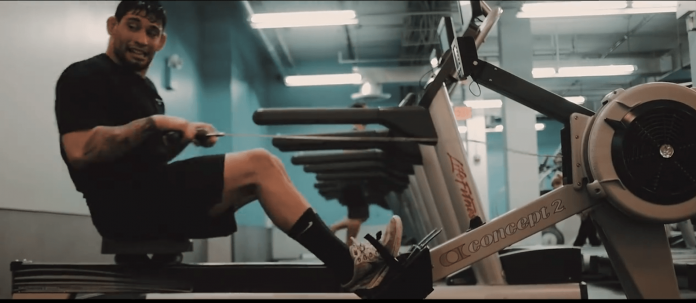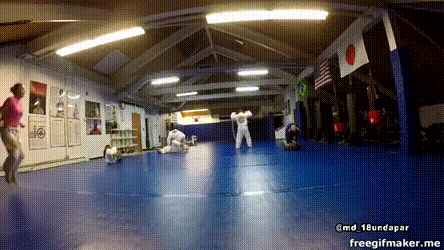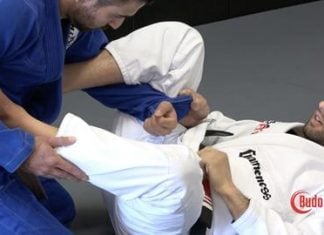
Tabata training is a method of training that is very popular lately. The basic notion is that you can get in perfect shape in just a few minutes. Tabata training is interval training with high intensity and very short duration. But does this protocol really work? And, even more importantly, is it any good for Brazilian Jiu-Jitsu?
Jiu-Jitsu is a very complex martial art that requires a long time to learn and even longer time to master. There are no shortcuts to learning the art, at least no feasible ones. Training, in general, is subject to this rule. There’s no way to get in shape really fast or learn grappling overnight. Becoming fit and healthy, and staying that way, requires work. In both the fitness industry and BJJ there are “methods” that claim to have the magic bullet. Is it really so or is it just cunning marketing? We can’t go into every one of these claims but we can dissect Tabata training. Especially in relation to BJJ training.
Currently, most of the industry fitness world is all about high-intensity interval training. This is the method to beat all other methods for fat loss and overall fitness. not only that, but it promises to get you into the shape of your life. This includes a gas tank to last for BJJ or another grappling martial art. Sounds too good to be true? Well, that’s perhaps because it is…
The Tabata Training Protocol
Most interval training methods of today are based on the famous 1996 study by Professor Izumi Tabata. Basically, Tabata training is a 4-minute workout in interval training fashion, at maximum intensity. The notion is that Tabata training has both aerobic and anaerobic benefits and is the ultimate fat loss tool. Let’s get something clear High-intensity interval training works. However, it does not work in 4 minutes, or at least not as advertised.

What is Tabata training then? It is training at extremely high intensity, 5 days a week, for Olympic level athletes on a specific piece of equipment. Unless you’re ticking all of these boxes, you’re not doing Tabata training. What’s more important, you’re not getting all the expected benefits of it.
There’s one more catch to the original Tabata training protocol. The group doing the workout also did additional steady-state cardio training. This fact is for some reason, omitted from most interpretations of the protocol. The Olympians actually did a day of steady-state work for 30 minutes four days per week. That’s a lot of added work on top of the HIIT method, isn’t it? The 4 minutes Tabata isn’t looking like 4 minutes anymore.
The Truth About Tabata Training
Going further into the study, let’s tackle the claim of intensity. Namely, 100% of someone’s VO2 max is associated with exhaustion and vomiting. So, what does 170% of someone’s VO2max mean than? That is the intensity required for true Tabata training.

Also, forget about losing any fat with Tabata training only. This is the biggest misconception about this method. Tabata won’t help you shed the fat o get int your desired weight class. Actually, fat loss using Tabata training has never been studied. Is it possible that it is effective for fat loss? Might be, since it is a form of high-intensity interval training which is a proven fat loss method. However, its effectiveness compared to other HIIT methods remains unknown at best.
How Good is Tabata Training For BJJ?
Let’s be clear: you aren’t and never will be doing the Tabata protocol or true Tabata training. It’s simply impossible. Doing actual Tabata training was exhausting even for Olympic-level athletes. Furthermore, trying to replicate the style and effects of the original Tabata workout means that you greatly increase the risk of injury. So, stop calling 4-minute rounds of high-intensity interval training Tabata. Even better, stop doing them completely. There are way better conditioning tools for grapplers, that are both more effective and safer. Energy system training is quite complex and needs proper structure.
Working more is not necessarily better, but the quality of movement is. 4 minutes of any kind of work is going to have a minimal impact on conditioning. So, if you need to repeat Tabata rounds for 5-6 sets, isn’t it better to spend the same amount of time training smart instead of just hard? After all, people that do a few hours of moderate-level activity are the longest living in the world. in addition, most BJJ matches are more of a mini-marathon than a sprint, where you need to know when to pace yourself. 20 seconds in a Tabata can seem like hell and you’ll never be able to go as hard for ten minutes. So, train smarter, not harder and reap the benefits of methods that work best for grappling.
Related Articles:
The Ins And Outs Of Energy System Training For BJJ
A Proven Fat Loss Workout Program For Jiu-Jitsu
Best Cardio For BJJ – The “Never Gas Out” Program
Sciatica Stretch Variations To Fix BJJ Lower Back Pain
Brutal Sprint Workouts For Jiu-Jitsu Conditioning


![Darce Choke Encyclopedia – Origins, Mechanics and Variations [2025] BJJ, choke, Brabo, BJJ Darce Choke, D'arce Choke, Darce BJJ Choke](https://bjj-world.com/wp-content/uploads/2017/11/JungPoirierLeeYahoo-218x150.jpg)









![Countering with Crab Ride Anthony Budion DVD Review [2025] Countering with Crab Ride Anthony Budion DVD Review](https://bjj-world.com/wp-content/uploads/2025/03/countering-with-crab-ride-anthony-budion-dvd-review-218x150.png)
![Closet Closed Guard Craig Jones DVD Review [2025] Closet Closed Guard Craig Jones DVD Review](https://bjj-world.com/wp-content/uploads/2025/03/closet-closed-guard-craig-jones-dvd-review-218x150.png)
![Xanadu Back Takes Levi Jones-Leary DVD Review [2025] Xanadu Back Takes Levi Jones-Leary DVD Review](https://bjj-world.com/wp-content/uploads/2025/03/xanadu-back-takes-levi-jones-leary-dvd-review-218x150.png)

![No-Gi Grapplers Guide To Front Headlock Joel Bane DVD Review [2025] No-Gi Grapplers Guide To Front Headlock Joel Bane DVD Review](https://bjj-world.com/wp-content/uploads/2025/03/no-gi-front-headlock-joel-bane-dvd-review-218x150.png)



![Assassin Choke Baret Yoshida DVD Review [2024] Assassin Choke Baret Yoshida DVD Review](https://bjj-world.com/wp-content/uploads/2024/10/assassin-choke-baret-yoshida-dvd-review-100x70.png)


![10th Planet Leg Locks Jeremiah Vance DVD Review [2025] 10th Planet Leg Locks Jeremiah Vance DVD Review](https://bjj-world.com/wp-content/uploads/2025/01/10th-planet-leg-locks-jeremiah-vance-dvd-review-100x70.png)
![Efficiently Executing X-Guard Giancarlo Bodoni DVD Review [2024] Efficiently Executing X-Guard Giancarlo Bodoni DVD Review](https://bjj-world.com/wp-content/uploads/2024/09/efficiently-executing-x-guard-giancarlo-bodoni-dvd-REVIEW-100x70.png)
![Shotgun Aoki Locks Mateusz Szczecinski DVD Review [2025] Shotgun Aoki Locks Mateusz Szczecinski DVD Review](https://bjj-world.com/wp-content/uploads/2025/03/shotgun-aoki-locks-mateusz-szczecinski-dvd-review-100x70.png)




![Countering Triangles And Omoplatas Adam Mazin DVD Review [2024] Countering Triangles And Omoplatas Adam Mazin DVD Review](https://bjj-world.com/wp-content/uploads/2024/10/countering-triangles-and-omoplatas-adam-mazin-dvd-REVIEW-100x70.png)

![Knee Lever John Wayne Sweep Adam Wardzinski DVD Review [2024] Knee Lever John Wayne Sweep Adam Wardzinski DVD Review](https://bjj-world.com/wp-content/uploads/2024/12/john-wayne-sweep-adam-wardzinski-dvd-review-100x70.png)
![Top Half Guard Neil Melanson DVD Review [2025] Top Half Guard Neil Melanson DVD Review](https://bjj-world.com/wp-content/uploads/2025/02/top-half-guard-neil-melanson-dvd-review-100x70.png)

![Daisy Fresh WHITE BELT Wrestling Curriculum DVD Review [2024] Daisy Fresh WHITE BELT Wrestling Curriculum DVD Review](https://bjj-world.com/wp-content/uploads/2024/10/daisy-fresh-white-belt-wrestling-curriculum-review-100x70.png)


![How To Knee Cut Junny Ocasio BJJ DVD Review [2025] How To Knee Cut Junny Ocasio BJJ DVD Review](https://bjj-world.com/wp-content/uploads/2025/02/how-to-knee-cut-junny-ocasio-bjj-dvd-review-100x70.png)
![Front Head Lock Kaynan Duarte DVD Review [2025] Front Head Lock Kaynan Duarte DVD Review](https://bjj-world.com/wp-content/uploads/2025/02/front-head-lock-kaynan-duarte-dvd-review-100x70.png)
![Leg Lock Strategies: Navigating Entanglements Jack Stapleton DVD Review [2024] Leg Lock Strategies: Navigating Entanglements Jack Stapleton DVD Review](https://bjj-world.com/wp-content/uploads/2024/12/navigating-entanglements-jack-stapleton-dvd-review-100x70.png)
![Woj Lock the World Chris Wojcik Ankle Locks DVD Review [2024] Woj Lock the World Chris Wojcik Ankle Locks DVD Review](https://bjj-world.com/wp-content/uploads/2024/12/woj-lock-the-world-chris-wojcik-dvd-review-100x70.png)
![Henry Akins Black Hole No-Gi Closed Guard DVD Review [2024] Henry Akins Black Hole No-Gi Closed Guard DVD Review](https://bjj-world.com/wp-content/uploads/2024/09/henry-akins-black-hole-no-gi-closed-guard-dvd-review-100x70.png)
![Advanced Chin Control Concepts David Petrone DVD Review [2025] Advanced Chin Control Concepts David Petrone DVD Review](https://bjj-world.com/wp-content/uploads/2025/01/chin-control-concepts-david-petrone-dvd-review-100x70.png)

![Reverse De La Riva System Mikey Musumeci DVD Review [2024] Reverse De La Riva System Mikey Musumeci DVD Review](https://bjj-world.com/wp-content/uploads/2024/11/reverse-de-la-riva-system-mikey-musumeci-dvd-review-100x70.png)
![The Whole Omoplata Enchilada Lyanne Perez DVD Review [2024] The Whole Omoplata Enchilada Lyanne Perez DVD Review](https://bjj-world.com/wp-content/uploads/2024/11/whole-omoplata-enchilada-lyanne-perez-dvd-review-100x70.png)
